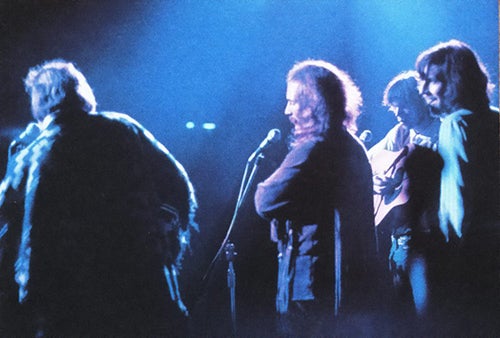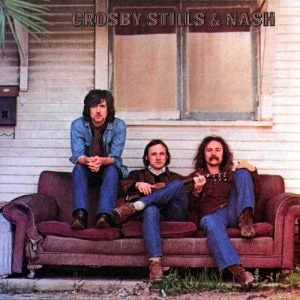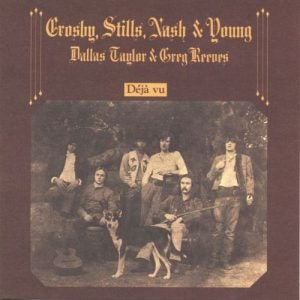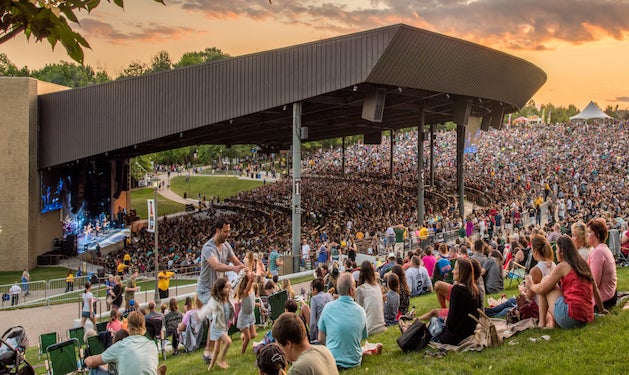Crosby, Stills, Nash & Young: 50 Years of Peace & Music
Woodstock was only the second live performance for newly formed supergroup, Crosby, Stills, Nash & Young, and they certainly were “scared shitless,” as Stephen Stills informed the Woodstock audience after the first song of their set. It wasn’t so much that they were scared to perform in front of half a million people; their trepidation came from the presence of Jimi Hendrix and other musical peers in the shadows on stage, waiting to see whether or not these disparate musical forces could bring the excitement of their recently-released debut studio album to the stage.
Day Three, Performer 7: Crosby, Stills, Nash & Young
Performed Monday morning, August 18, 3:30–5:00 am

Crosby, Stills & Nash had only performed publicly as a group once before they arrived at Woodstock. Shortly before the festival, Neil Young was added to the group, making Woodstock CSNY's first public performance. Left to right: Stephen Stills, David Crosby, Neil Young, and Graham Nash. Photo © Barry Z Levine.
- David Crosby: guitar, vocals
- Stephen Stills: guitar, vocals
- Graham Nash: guitar, vocals
- Neil Young: guitar, vocals
- Greg Reeves: bass
- Dallas Taylor: drums
Crosby, Stills, Nash, & Young's Woodstock setlist:
- Suite: Judy Blue Eyes
- Blackbird
- Helplessly Hoping
- Guinnevere
- Marrakesh Express
- 4 + 20
- Mr. Soul
- I'm Wonderin'
- You Don't Have to Cry
- Pre-Road Downs
- Long Time Gone
- Bluebird
- Sea of Madness
- Wooden Ships
- Find the Cost of Freedom
- 49 Bye-Byes
The Early Years
Guitarists/vocalists/songwriters Stephen Stills and David Crosby had been friends since 1966 when Stills formed the band Buffalo Springfield in Los Angeles with fellow singer/songwriter Neil Young. Crosby was already famous as a member of the legendary Los Angeles folk-rock group The Byrds, and the musical and personal connection between himself and Stills was a natural one, with Crosby sitting in for an absent Young at the 1967 Monterey International Pop Festival. By 1968, Crosby had been fired from The Byrds amid escalating musical and personal differences with his bandmates, and Buffalo Springfield had similarly fallen apart shortly after Neil Young left to pursue a solo career.
In July 1968, holed up and at loose ends in Los Angeles, Stephen Stills and David Crosby found themselves at a party at the home of up-and-coming folk singer/songwriter Joni Mitchell when they were joined by Graham Nash for a performance of a new Stills song called “You Don’t Have To Cry.” Nash was a recent British expatriate who had a string of hits with The Hollies to his credit. When Nash joined in with Crosby and Stills’ harmony blend, the three knew that they were onto something major and resolved to form a band in short order, with Nash quitting The Hollies to devote himself full-time to the project. The trio recorded some demos, which were reportedly rejected by The Beatles’ Apple Records label, but this did not deter the cocky newcomers. Stills was still under contract to Atlantic Records through his work with Buffalo Springfield, and this turned out to be a good thing when the new group, dubbed Crosby, Stills & Nash, inked a record deal with Atlantic label boss Ahmet Ertegun and began working on material for their debut album.
One of the Hottest Acts of 1969
After working out contractual difficulties arising from Graham Nash being under contract to Epic Records from his time with The Hollies, Crosby, Stills & Nash’s self-titled debut album was released in May 1969. It was an instant and massive success, peaking at #6 in the U.S. and sending shockwaves throughout the music industry where it was heralded as the dawn of a new musical era, away from psychedelic rock and pop and moving toward a more mature, reflective musical landscape. The album spawned two Top 30 hits in the U.S. in the form of the lengthy and stunningly gorgeous Stills-penned anthem “Suite: Judy Blue Eyes” and Nash’s fun pop ditty “Marrakesh Express,” and the band was quickly established as one of the hottest acts around in the summer of 1969.

was an instant hit,
and the Woodstock audience
knew their music well
In order to promote the album, the band was going to need to tour, but this was initially difficult given the fact that Stephen Stills had played most of the instruments on their debut album apart from the drums, which were played by Los Angeles session drummer Dallas Taylor. Ahmet Ertegun suggested former Stills’ former Buffalo Springfield partner Neil Young to fill the keyboard slot, and although Stills and Young had to resolve lingering differences from their time working together, Young became a full-time member of the band in July 1969 (under the terms of his agreement to work with CSN, Young was able to continue his solo career). After a failed attempt to work with former Buffalo Springfield bassist Bruce Palmer, the initial live lineup of Crosby, Stills, Nash & Young was rounded out with Motown bass whiz Greg Reeves, who was a mere 14 years old at the time that he joined the new band. Although the band was largely untested in a performance sense, one listen to their debut album in the spring of 1969 was enough for promoter Michael Lang to sign CSN (now with added Y) to play at Woodstock.
Soothing Harmonies During the Last Night of Woodstock
As Sunday evening drifted into Monday morning, much of the Woodstock crowd was on their way home. Those unfortunate people who chose to leave missed some of the most incredible and historic performances of the entire weekend, one of which kicked off around 3:30 am when Crosby, Stills & Nash made their way to a set of stools at center stage. They had played their first-ever gig the night before at the Auditorium Theater in Chicago, but nothing could have prepared them for their marquee set at Woodstock. Opening their Woodstock set acoustically, the group kicked off with Stills’ “Suite: Judy Blue Eyes,” establishing an instant rapport with the audience. This was followed by a Beatles tribute in the form of a gorgeous version of Paul McCartney’s “Blackbird,” their soothing harmonies floating through the inky black night.
Another Stills tune followed with “Helplessly Hoping” before Stephen stepped aside and the duo of Crosby and Nash performed Crosby’s haunting “Guinnevere,” both tunes taken from their debut album. A peppy version of Graham Nash’s “Marrakesh Express” (with Stills’ maracas accompanying Nash’s guitar) had the crowd clapping along; the song being a current FM radio favorite as well as a Top 30 single. The initial trio set ended with a new song, Stills’ “4+20,” which would be released the following year on their second album, Déjà Vu.
Neil Young Shocks the Audience
At this point, Graham Nash announced a special event—Crosby & Nash cleared out, leaving Stephen Stills to reunite with Neil Young, his Buffalo Springfield colleague who had recently been conscripted into the supergroup, making the band Crosby, Stills, Nash & Young. Most in the crowd were unaware of this addition and the response was tremendous, especially as Stills & Young came out swinging with a rough and ready acoustic version of the Springfield’s “Mr. Soul,” Stills playing lead lines behind Young’s spade-thrusting rhythm. Another Neil Young composition followed with the country bounce of “Wonderin’,” a tune that he would not release for another 13 years. The acoustic set concluded with Stills’ “You Don’t Have To Cry” from the first album, CSN&Y harmonizing tightly on the song that got them singing together for the first time.
The band was then joined by bassist Greg Reeves and drummer Dallas Taylor for an electric set. This started with Nash’s “Pre-Road Downs,” a song about the anxiety a musician must deal with before going out on tour. The electric band was wild and exuberant, perhaps too much so at times, although they clearly were genuinely enthusiastic and mindful of the historical nature of the occasion. David Crosby’s “Long Time Gone” followed, with the group nearly off the rails on a song that would become a Woodstock anthem after the studio version from their debut album was used in Michael’s Wadleigh’s documentary of the festival. A version of Buffalo Springfield’s “Bluebird” kept the set moving, and Neil Young’s only lead vocal of the electric set was then laid on the crowd with a song that would go unreleased in a proper studio version, “Sea Of Madness.” The electric set ended with a powerful version of the Paul Kantner/Stephen Stills/David Crosby tune “Wooden Ships,” a much more tightly-focused performance than the one Jefferson Airplane offered the previous morning.
For the encores, CSN (possibly sans Y, recordings do not make his involvement or lack thereof clear) reverted to their acoustic format with a pair of Stephen Stills tunes. The first was the brief but gorgeous “Find The Cost Of Freedom” which would emerge as a single B-side the following year, and their performance closed with the appropriate “49 Bye-Byes” from the first album.
After Woodstock
The weary band then headed off to New York City for a post-Woodstock performance on The Dick Cavett Show also featuring Jefferson Airplane and Joni Mitchell (who hadn’t attended Woodstock, but who would write the definitive anthem for the festival which was later turned into a hit single by CSNY). As a badge of honor, CSN were wearing the very same mud-spattered outfits they had worn for their Woodstock set the night before.
Buoyed by their success at Woodstock, their 1970 album, Déjà Vu, featured the lineup that played at the festival, with cameo appearances by fellow Woodstock alumni John Sebastian and Jerry Garcia and was another massive success. The band has always been known for its strong personalities, egos and creative differences, and there have been numerous breakups, reunions, side projects, and pairings through the years.

record their masterpiece, Déjà vu,
accompanied by Dallas Taylor and Greg Reeves,
their Woodstock drummer and bassist
Where Are They Now?
They continued to perform and record until 2016 when personal differences between David Crosby and his CSNY partners appeared to split the group for good. While Crosby, Stills, Nash & Young all continue to pursue solo careers, bassist Greg Reeves left the band in 1970 and has contributed to several of CSNY’s solo projects and albums by Dave Mason and George Clinton. Drummer Dallas Taylor continued in the music industry for a time but left to pursue a career as a drug counselor. He died from liver disease in 2015.
—Wade Lawrence & Scott Parker
